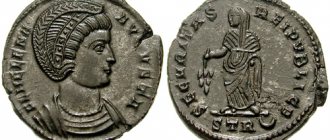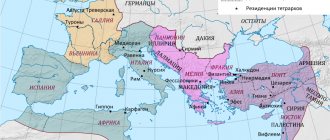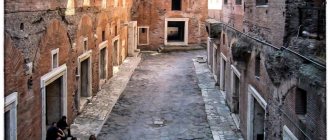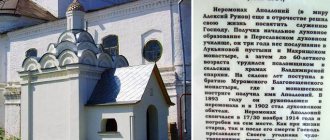| Head of the Colossus of Constantine (unknown sculptor, c. 312-325). Capitoline Museums, Rome |
Constantine I the Great
(
Flavius Valerius Constantine
) (+ 337), saint Equal to the Apostles, Emperor of Rome (306-337) Commemorated May 21
Constantine the Great was the son of Constantius Chlorus, ruler of the Western Roman Empire (Gaul and Britain), and Saint Helen Equal to the Apostles. Constantine's father did not persecute Christians, while in all other parts of the great empire they were subjected to severe persecution. At the request of Emperor Diocletian, in his youth (18 years old) he was taken from his parents as a hostage and lived at court in Nicomedia. When Diocletian abdicated the throne, Constantine returned to Gaul and was proclaimed emperor in 306 (after the death of Emperor Constantius).
He was encouraged to accept Christianity by his mother. His father, although he was a pagan, patronized Christians, seeing that Christians were faithful servants and honest citizens. At the court of Diocletian, at a time when he had not yet persecuted the Church, there were Christians in various positions, and Constantine had many occasions to ascertain their honesty and devotion to duty. Then he saw the horrors of persecution and the extraordinary firmness of Christ's confessors, and this also predisposed him in their favor. Subsequently, Constantine himself admitted that his stay at the court of Diocletian greatly contributed to his conversion to Christianity: “I was alienated from the hitherto rulers, he said, because I saw the savagery of their morals.”
By his nature, active, militant, accessible and generous to everyone, far-sighted and insightful, Constantine displays the traits of a world genius, and it was not in vain that he was chosen by God's Providence to carry out the greatest revolution in the empire and throughout the world.
During his reign, Emperor Constantine fought in particular against three enemies, and during this struggle he gradually but decisively leaned toward accepting the holy faith.
| Equal. Tsar Constantine the Great. Greek icon, XXI century) |
In 308, he happily emerged from the struggle with Emperor Maximian Herculus and hastened to express his gratitude to the deity with rich sacrifices in the temple of Apollo.
This revealed a dominant feature in the character of Constantine: although he still remained a pagan, he was a pious man and attributed the reason for his success to help from above. In 312, a new war broke out between Emperor Constantine and Caesar Maxentius, the son of Maximian. During this war, shortly before the decisive battle at midday, when the sun had already begun to lean towards the West, Constantine with his own eyes saw a luminous cross in the sky with the inscription: “By this (this) conquer” (in Greek: ἐν τούτῳ νίκα). At night, in a dream, the Lord appeared to him with the same sign of the cross and said that with this sign he would defeat the enemy. The next day, by order of Constantine, images of the holy cross were made on all the signs of his army.
Having defeated Maxentius, Constantine solemnly entered Rome and here in the square he ordered to erect his statue with a cross in his right hand and with the inscription: “With this saving banner I saved the city from the tyrant’s yoke.”
Constantine did not stay in Rome for long and went to Milan, most likely, at the beginning of 313. Licinius also arrived here. Here the marriage of Licinius to Constantine’s sister was celebrated, and their union was further strengthened. They stayed in Milan no longer than April. Here they drew up a legislative decree that determined the position of Christians in the empire. This document is known as the Edict of Milan of 313.
Meanwhile, the friendly relations between the emperors Constantine and Licinius gradually deteriorated and turned into open struggle. This struggle was to decide the fate of Christianity in the Roman Empire, because Licinius, suspecting Eastern Christians of greater attachment to Constantine, first began to oppress them, and then went over to open persecution of them, and Constantine clearly patronized Christians. Both emperors were preparing for a decisive struggle, each in accordance with his faith. Oracles predicted victory for Licinius, and Christians prayed for Constantine. God granted victory to Constantine in two battles, first at the Battle of Adrianople (322) on the European continent, and then at Chrysopolis (modern Yuskudar) in Asia Minor. Licinius was removed from power and eventually executed. Constantine became the sole ruler of the empire, and Christianity triumphed.
| Equal. Tsar Constantine. Mosaic in the Hagia Sophia in Constantinople (late 10th century) |
Emperor Constantine devoted his entire life to the good of the Church and did so much good to it that he earned the title of Equal-to-the-Apostles.
Since his time, government institutions, laws, and military service began to focus on the requirements that lie in Christianity. It can be indicated that the following measures and actions of Emperor Constantine in favor of Christianity, in addition to the mentioned edicts, are in order of time: he stopped pagan games (314), freed the clergy from civil duties and church lands from general taxes (313-315) , abolished execution by crucifixion and issued a strict law against the Jews who rebelled against the Church (315), allowed the freeing of slaves in churches without special formalities, which were very difficult in civil courts (316), prohibited private individuals from making sacrifices to idols and turn to fortune telling at home, leaving this rule only to society (319), ordered the celebration of Sunday throughout the empire (321), and, to protect Christian virgins, abolished the Roman laws against celibacy; granted the Church the right to receive property under wills, allowed Christians to occupy the highest government positions, ordered the construction of Christian churches and prohibited the introduction of imperial statues and images into them, according to the custom of pagan temples (325).
During the reign of Constantine, the former name of the city of Jerusalem was restored instead of the new one, Julius Capitolinus, given to it under the emperor Hadrian.
Most of all, Emperor Constantine encountered opposition in Rome, where the pagan party was strong. This opposition of the pagans was revealed especially during Constantine’s celebration of the 20th anniversary of his reign and cooled him towards the former capital of the state. His favorite city was Serdica (now Sofia), about which he said: “Serdica is my Rome.” Finally, he completely left Rome and began to rule from Serdica. It was there that the decision was made to found a new Christian capital of the empire [1]. It became the city of Byzantium on the banks of the Bosphorus, where the holy king invited Christian bishops to solemnly consecrate it, calling it Constantinople. Instead of pagan temples, Christian temples began to be erected in this new capital of the empire, and instead of statues of pagan gods - sacred images.
| Equal App. Kings Constantine and his mother Helen. Novgorod icon (XVII century) |
Emperor Constantine paid close attention to the unrest that was aroused in the Church by the Donatist schism and especially the heresy of Arius, and tried in every possible way to reconcile those divided.
One of the greatest merits of Constantine was the convening of the First Ecumenical Council in the city of Nicaea in 325. Constantine had many excellent qualities, but the murder in 326, first of his son Crispus, arranged by his stepmother Fausta, and then, when the son’s innocence became clear, of Fausta herself, shows him from the other side.
Devoted to the Church with all his soul, Constantine, however, according to the custom of that time, postponed accepting baptism until the last days of his life. When he felt the approach of death, he accepted this great sacrament with reverence and died peacefully during prayer on the day of Pentecost, May 21, 337.
Constantine died in Achiron, a suburb of Nicomedia, during preparations for the war with Persia; before his death, he pre-divided the Roman Empire between his three sons: Constantine II (reigned 337–340) received Britain, Spain and Gaul; Constantius II (ruled 337–361) received Egypt and Asia; Constans (reigned 337–350) received Africa, Italy and Pannonia, and after the death of his brother Constantine II in 340, the West was completely ceded to him. Illyricum, Armenia and Pontus went to two nephews of Constantine - Delmatius and Hannibalian. It cannot be said that such a division was far-sighted: immediately after the death of Constantine, almost all of his relatives were exterminated by the army, which wanted to protect the throne from new claimants. Clashes between the heirs continued until, in 350, only one emperor remained, Constantius II.
Prayers
Troparion, tone 8
Having seen the image of Your Cross in heaven,/ and just as Paul did not receive the title from man,/ Your apostle is among kings, O Lord,/ Place the reigning city in Your hand:/ save it always in world, // through the prayers of the Mother of God, the One Lover of Mankind
.
Kontakion, tone 3
(Similar: Virgo today) from the service of Equal App. To Konstantin and Elena May 21:
Constantine today, with the mother Helen,/ the cross is revealed, the all-honorable tree,/ the shame of all the Jews is,/ a weapon against the enemy of the faithful kings:
[2]
/ for our sake a great sign appeared // and in terrible battles
.
Greatness
equal to app. To Constantine and Helena from the Book of Hours published by the Kiev Pechersk Lavra in 1642:
We magnify you,/ holy kings equal to the apostles, Constantine and Helen,/ and we honor your holy memory,// who enlightened the entire universe with holy baptism.
Greatness
equal to app. To Constantine and Helen from the modern Menaion [3]:
We magnify you,/ holy saints and Equal-to-the-Apostles Tsars Constantine and Helen,/ and we honor your holy memory,/ for you, through the Holy Cross// enlightened the entire universe of nature.
Saints Constantine and Helen
Estimated reading time: less than a minute.
June 3 is the day of remembrance of the saints Tsar Constantine and his mother Queen Helena. In the Orthodox Church, the great mother and son are glorified as equal to the apostles - their feat of preaching the Gospel and converting peoples to the faith is so significant. Constantine was born in the Serbian city of Nis, in 272. Elena - in Drepan (Asia Minor), later renamed Elenopolis in honor of her. The year of birth of Elena herself is not precisely established...
Ambrose of Milan wrote that Helen was the daughter of an innkeeper and met the future emperor Constantius Chlorus, Constantine's father, when he, still a young officer, was riding horses, and she served him wine.
When Constantine was 21, his father divorced Helena in order to marry the daughter of Emperor Maximian and strengthen his position at court. He became Caesar of the province of Gallia Belgica. In 306, after his death, Constantine was proclaimed emperor of this province.
In 312, Constantine entered into a power struggle with the usurper Maxentius. On the eve of the decisive battle, he had a dream: he needed to draw an image of the Christian cross on the banners, and then he would win (“and thus win”). And so it happened. Constantine became emperor of the western part of the Roman Empire. He succeeded in completely unifying the lands in 321.
In 313 in Milan, at the wedding of his sister, Constantine, who believed in Christ, announced an edict that legalized Christianity on the territory of the Roman Empire. Emperor Diocletian, an ardent persecutor of Christians, was also invited to the feast as an honorary guest. However, he did not come.
Elena, while in Trier, gave part of her house to the Christian community of the city so that a church could be built there. It became one of the oldest official churches, along with the Church of the Holy Sepulcher and the Church of the Nativity in Bethlehem. Constantine gave his mother the title of empress. The first coins found with her image date back to 318.
Saint Helena became a Christian at the age of 60. In 326, she made a pilgrimage to Jerusalem, where she undertook archaeological research, discovering the Cross of the Lord, nails and a tablet with the inscription “Jesus of Nazareth, King of the Jews.” At the time of this trip she was about 80 years old.
In 325, Constantine convened the First Ecumenical Council, where the Creed of Christians was formulated. At this council, the emperor personally greeted the confessors of the faith who suffered during the years of persecution, kissing their wounds. In 320, he moved the capital of the Roman Empire to a new city - Constantinople, which later became the center of the Eastern Empire - Byzantium.
Constantine dreamed all his life of being baptized in the Jordan, but was baptized shortly before his death at his residence near Constantinople. He died in 337. The exact date of Elena's death is unknown
We thank Timofey Katnis for his help in preparing the material. Drawings by Elena Popovskaya
Icon of Constantine what to pray for
The icon of St. Constantine depicts the Roman emperor, who did a lot for the development of Christianity. If it were not for this man, it is unknown how widely the Christian faith would have spread and what it would be like now.
Constantine the Great - this is what the emperor is called in all history textbooks, feature films and documentaries, and literary works. In Christianity, he and his mother, Helen, are revered as equals to the apostles.
This man was born in 272 or 274, as historians believe, on the territory of modern Serbia, in a place called Naiss. Now this is the city of Nis. It is impossible to establish the exact date of birth of the future saint, but the day of his birth does not cause controversy - it is February 27.
There is practically no information about the childhood of the future emperor. The first mention of him in the chronicles dates back to 306, during which the army proclaimed Constantine Augustus, that is, emperor.
Constantine's mother, Helen, revered in Christianity along with her son, was not his father's wife. This is an unprecedented case of canonization, and in such a rank, of a woman who spent her life in sin. Elena was a concubine. This is how in Rome they called women of low origin who cohabited with men outside of marriage, who were supported, but who were not harlots. Children born in such unions had no rights to property, status, titles, etc. Of course, such a nuance also complicated Constantine’s rise to power no less than the political crisis and the four tetrarchs with the troops supporting them.
The Emperor not only stopped the persecution of Christianity and the persecution of those who professed this faith. He did much more. The emperor officially moved the capital from Rome to Constantinople, then called Byzantium, and initiated the convening of the Council of Nicaea. In general, he actively took part in the formation of the church as an integral structure with its own hierarchy, order, distribution of responsibilities between employees and other features characteristic of any organization.
In addition, Constantine is the first Christian emperor in world history. In addition to the fact that the emperor himself was baptized, he also gave Christianity the status of a state religion. This is extremely important, because without this status, there would be no active missionary activity and mass dissemination of faith in Christ. In fact, Constantine took a religion that had neither a clear structure, nor a large number of followers, nor a significant number of temples and priests, to a new level for it. It can be argued that the emperor was the one who made the church as the whole world knows it today.
The icon of St. Constantine is an image that was made by different masters without following a single style. Even the emperor's appearance is described with differences. However, none of the works resembles surviving Roman busts depicting the emperor. He is depicted with his mother carrying a crucifix, in the form of a stern king with knitted eyebrows, he is depicted as a young man and an old man. And of course, not a single icon of St. Constantine suggests why this man turned to Christ.
The second legend is not as beautiful as the first. It says that the emperor was afraid of the punishment of the gods for a very serious crime - the murder of his first wife and son. According to legend, Constantine suspected them of having an intimate relationship, flew into a rage and executed both of them without sorting it out. At that time, the emperor was already divorced from his first wife and was married to the stepdaughter of one of the very noble citizens of Rome. There is another version that connects the first-born of the emperor not with his mother, but with the second wife of Constantine.
When he felt the approach of death, he was afraid of posthumous torment and adopted another religion, in which he was forgiven of his terrible sin. No one can say how true this legend is. However, the benefactor of Christianity was actually baptized only before his death, at the very end of his life.
The icon of the holy Equal-to-the-Apostles Tsar Constantine and his mother Helen is brought out for veneration on May 21 or June 3, depending on the style of chronology. On the same day, services are held in his honor, and those named by the same name celebrate the day of the Angel.
Particular importance is attached to the icon, which depicts not only the emperor, but also his mother carrying a cross. It is generally accepted that one should pray in front of this icon before starting any business or making important changes in life. It is customary to light a candle in front of this image on the eve of the start of construction of a house.
Not a single existing icon of St. Constantine, either depicting only him or dedicated to him and his mother, is miraculous. The very first ancient image of the erection of the Holy Cross by Helen and Constantine, created in Byzantium, is considered lost.
Who does Saint Constantine help and with what? The icon and prayer to him will protect him from misfortunes in business, business, and when communicating with government officials. The saint patronizes people who are strategists, regardless of the field in which they work. Helps bring plans to life.
Here is a small list demonstrating what it is customary to pray for to the holy icon of Constantine:
Of course, they turn to the saint with other requests. But, as a rule, they do not ask Constantine to grant personal happiness and other similar things.
Icon of Constantine the Great linden board, gesso, tempera, gilding
* The cost of the icon is indicated for a standard sample of a standard size and may vary depending on the type of decoration and additional images.
The decoration of the icon can be done in the form of gilding the background with gold leaf or individual elements (halo).
It is possible to engrave the surface of the icon (ark, halo, fields).
The icon can be made in an icon case with various types of frames.
A certificate is included with the icon.
The exact cost can be found out by filling out the order form, by phone and in messengers.
Perhaps the icon you need is in stock!
Memorial Day: June 3
The icon of Constantine the Great is presented on our website.
Emperor Constantine the Great was the son of the Roman king Constantius Chlorus, who ruled the western part of Gaul and Britain. His mother was Equal-to-the-Apostles Saint Helen. Emperor Diocletian took Constantine the Great as a hostage to the palace of Nicomedia. In 306, when Diocletian abandoned his empire, Constantine returned home. His father Constantius had already died, and Constantine took over the reins of government.
It was his mother who persuaded Konstantin to accept Christianity. Although his father was a pagan, he patronized Christians and said that they were honest citizens and faithful servants. Even while Constantine was serving at the court of Diocletian, he became convinced of the honesty and devotion to duty of the Christians who then served the emperor. Then persecution began against Christians, and Constantine saw that true Christians never betrayed their faith.
Generous, active, warlike, insightful Constantine was chosen by God's Providence to carry out the greatest revolution in his empire and throughout the world. DURING his reign, the great Constantine fought against three enemies, after which he inclined to accept the Christian faith. In 308, while still a pagan, Constantine won the war with Emperor Maximian Herculus. In gratitude, he took generous gifts to the pagan deity to the temple of Apollo. By this act he showed his piety, and he attributed his victories to help from above.
Over time, the friendship between Constantine and Licinius developed into a struggle over Constantine's patronage of Christians. In the battle, the Lord granted victory to Constantine. After the death of Licinius, Constantine became sole emperor, and Christianity triumphed.
Saint Constantine the Great did a lot of good for the good of the Church, for which he was called Equal-to-the-Apostles. The martyr Constantine the Great, whose icon displays the face of a holy man, helped the Christian people.
You can choose an icon from the photographs presented above - these are real works of our masters. If for some reason the image we have does not suit you, you can offer us yours using an individual order or ask the administrator to pick it up for you by phone or via instant messengers. You can also come to our workshop, see our work and place an order on the spot. We are always happy to meet the client in person.
You can order an icon by phone.
You can also fill out the form below and click the “Submit” button - our administrator will contact you shortly and accept your order.
We agree on the order execution time before starting work. And we always deliver icons on time!
Delivery of the icon is carried out by our representative (Moscow and Moscow Region) or by a transport company to your door. The icon is delivered in a beautiful cardboard box; the icon is accompanied by a certificate indicating the artist and the materials used.
* Please note that the final order configuration (sample, size, finish) is clarified by phone or e-mail; this form serves only for feedback. You can indicate your wishes in the “Note” field.
Great holy kings equal to the apostles
Konstantin and Elena
On June 3 (May 21, old style) the Church celebrates the memory of the great saints - Tsars Constantine and Helen.
At the turn of the 3rd and 4th centuries, the Roman emperor Diocletian divided the huge Roman empire into two halves to make it more convenient to govern. He ruled the eastern half of the empire himself, with Caesar Galerius as his assistant. In the western half, he installed Maximian as emperor, and Caesar Constantius Chlorus, who ruled Gaul and Britain, as his assistant. Constantius Chlorus, being officially a pagan by his position, worshiped the One God in his soul along with all his household. In 303, Diocletian issued a decree to eradicate Christianity throughout the Roman Empire. Constantius Chlorus, although he could not openly disobey the elder emperor, continued to patronize Christians, especially after the conversion of his wife, the holy Queen Helen, to Christ.
Konstantin and Elena.
St. Constantine, the only son of Constantius Chlorus and St. Queen Helena, was born in the year 274, and although officially he grew up as a pagan, he was raised at home in a Christian environment. Being a direct witness to the terrible persecution of Christians instituted by Diocletian, St. Constantine simultaneously saw the triumph of the faith of Christ, which was manifested in countless miracles and God's help to the holy martyrs. St. Constantine was tall, handsome and physically strong, at the same time kind and modest, for which he was loved by the people and the army. This caused him to be envied by other courtiers, especially Caesar Galerius, who even plotted against Constantine to deprive him of control of his part of the empire. Then St. Constantine retired to Gaul to his father, and after the death of Constantius Chlorus, in the year 306 the army proclaimed Constantine emperor of Gaul and Britain. Konstantin was then 32 years old. Having assumed power, the first thing he did was declare freedom to practice Christianity in his regions.
In 311, the cruel tyrant Maxentius reigned in the western half of the empire, who wanted to get rid of Constantine and rule the empire alone. Then Constantine himself, in the year 312, decided to undertake a military campaign against the Roman emperor in order to rid Rome of the evil tormentor. This hike was incredibly difficult, because... the enemy army was more numerous, and in addition, Maxentius called upon demonic power for help, protecting himself and his army with various spells. Constantine realized that relying only on human strength was not enough, and then he remembered the true God and began to pray to Him, asking for help from above.
By his first decree, the new emperor declared complete religious tolerance to the subject peoples; at the same time, he accepted Christians under his protection, abolished execution by crucifixion and issued laws favorable to the Church of Christ.
Meanwhile, the ruler of the eastern half of the empire, the pagan Licinius, also a cruel and treacherous tyrant, went to war against Constantine. Armed with the power of the Cross, Emperor Constantine opposed Licinius and completely defeated him, now becoming the sovereign of the entire Roman Empire. The victory over Licinius further confirmed Constantine in the consciousness of God's help, and he worked hard to spread the faith of Christ among his subjects, declaring Christianity the dominant religion in the empire.
In the matter of spreading Christianity, Emperor Constantine received a lot of help from his mother, the holy Queen Helen. When Tsar Constantine wished to build temples of God on sacred places in the Holy Land (i.e., at the site of the birth, suffering and resurrection of Christ), and also to find the Cross of the Lord, Queen Helen joyfully took up this task. In the year 326, she went to Jerusalem and put in a lot of work to find the Cross of Christ, which was deliberately buried in the ground by the enemies of Christ. Having found the true and life-giving Cross of the Lord, St. Queen Helena moved the people to bow to him. The Church celebrates this event with the twelfth feast of the Exaltation of the Cross of the Lord. Queen Helena brought part of the Cross, as well as nails and thorns from the crown of thorns, to Rome to her son Constantine, and left the other part in Jerusalem. Then Saints Constantine and Helen, over the place of the suffering, burial and resurrection of Jesus Christ, built a huge and magnificent temple in honor of the Resurrection of Christ. This temple, containing Golgotha and the Holy Sepulcher, is to this day the main holy place in Jerusalem. For their merits and zeal for the spread of the Christian faith, Emperor Constantine the Great and Queen Helena received from the Church the title of holy kings equal to the apostles (i.e. equal to the apostles). Holy King Constantine died on the very day of Pentecost in the year 337.









